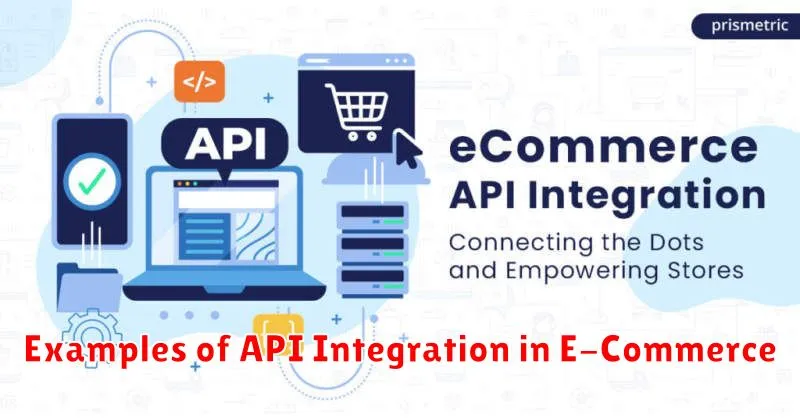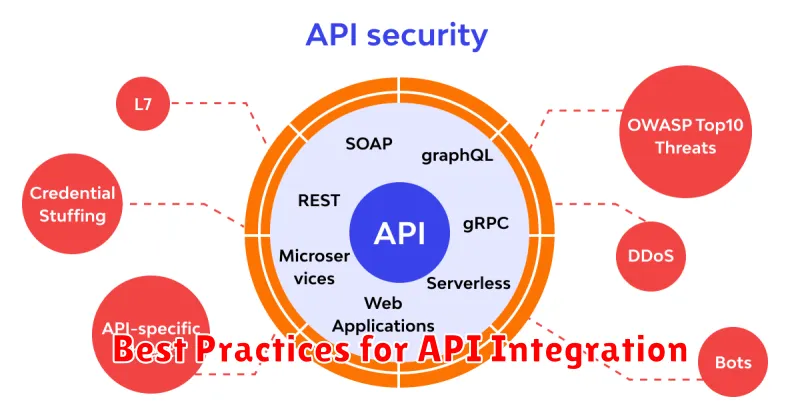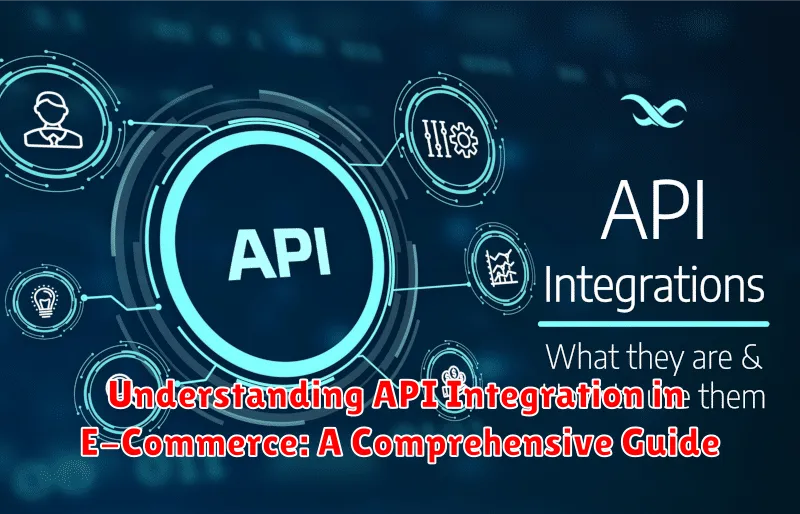In today’s interconnected digital landscape, API integration plays a crucial role in the success of any e-commerce business. E-commerce API integration allows different software systems to communicate and share data seamlessly, streamlining operations, enhancing customer experience, and ultimately driving growth. This comprehensive guide will delve into the intricacies of API integration for e-commerce, exploring its benefits, challenges, and best practices. Whether you’re a seasoned developer or an e-commerce entrepreneur, understanding the power of APIs in e-commerce is essential for staying competitive in the modern marketplace. From inventory management and order fulfillment to payment processing and customer relationship management (CRM), e-commerce APIs can revolutionize the way you do business.
This guide will provide a detailed overview of e-commerce API integration, covering various types of APIs, including REST APIs and SOAP APIs. We’ll explore common e-commerce API integrations such as payment gateways, shipping providers, and marketing platforms. Furthermore, we’ll discuss security considerations, API documentation, and the future of API integration in the e-commerce landscape. By the end of this guide, you’ll have a strong understanding of how to leverage API integration to optimize your e-commerce platform and achieve significant business outcomes.
What is an API?
API stands for Application Programming Interface. It’s essentially a set of rules and specifications that software programs can follow to communicate with each other. Think of it as a messenger that allows different systems to interact and exchange information seamlessly. APIs define the kinds of requests that can be made, how to make them, the data formats that should be used, and the conventions to follow.
In simpler terms, an API acts as an intermediary between two applications, allowing them to share data and functionality without requiring direct access to each other’s code. This modular approach promotes flexibility, simplifies development, and enables the creation of integrated systems.
A practical example is ordering food online. When you submit your order through a restaurant’s app, the app uses an API to communicate with the restaurant’s system. The order details are transmitted via the API, and the restaurant’s system confirms the order back to the app, which then updates your order status.
Types of APIs Used in E-Commerce
Several API types are commonly employed in e-commerce, each serving distinct functions. Understanding these types is crucial for selecting the appropriate APIs for your business needs.
Product Information APIs
These APIs allow access to product catalogs, including details like descriptions, pricing, and availability. This enables businesses to showcase products from various suppliers or create comparison shopping platforms.
Payment Gateway APIs
Payment gateway APIs facilitate online transactions by securely processing customer payment information. They connect the e-commerce platform with payment processors, simplifying the checkout experience.
Shipping APIs
These APIs integrate with shipping carriers, providing real-time shipping rates, tracking information, and label generation. This streamlines order fulfillment and enhances transparency for customers.
Customer Relationship Management (CRM) APIs
CRM APIs connect e-commerce platforms with CRM systems, allowing for synchronized customer data. This enables personalized marketing campaigns and improved customer service.
Benefits of API Integration
API integration offers numerous advantages for e-commerce businesses, streamlining operations and enhancing customer experiences. It allows for real-time data synchronization, ensuring consistency across different platforms and reducing manual data entry. This leads to improved accuracy and efficiency in managing inventory, orders, and customer information.
APIs enable enhanced functionality by connecting your e-commerce platform with other software solutions. This allows you to add features like advanced shipping calculations, payment gateways, and marketing automation tools, improving the overall customer journey.
Scalability is another key benefit. APIs allow your e-commerce business to grow and adapt to changing demands by seamlessly integrating with new systems and services as needed. This flexibility is crucial for staying competitive in the dynamic e-commerce landscape.
By automating processes and improving data flow, API integration can lead to significant cost savings. Reduced manual effort and improved efficiency translate to lower operational costs, contributing to higher profitability.
Finally, APIs enhance the customer experience by providing personalized recommendations, streamlined checkout processes, and access to real-time order tracking information. This personalized approach can lead to increased customer satisfaction and loyalty.
Examples of API Integration in E-Commerce

API integrations are the backbone of modern e-commerce functionality. Here are a few practical examples:
1. Payment Gateway Integration
Payment gateways like PayPal, Stripe, and Square rely on APIs to securely process transactions within the e-commerce platform. This allows customers to make purchases without leaving the website.
2. Shipping and Logistics APIs
Real-time shipping calculations and tracking updates are facilitated by integrating with shipping providers like UPS, FedEx, and USPS. These APIs provide accurate shipping costs and delivery estimates, enhancing the customer experience.
3. Social Media Integrations
APIs enable seamless sharing of products on social media platforms. This integration allows customers to easily share their favorite items with their networks, driving organic traffic and brand awareness.
4. Customer Relationship Management (CRM) Integration
Connecting e-commerce platforms with CRM systems like Salesforce or HubSpot via APIs allows for automated data synchronization. This helps businesses personalize marketing campaigns and improve customer service based on comprehensive customer profiles.
How to Choose the Right API for Your Business
Selecting the appropriate APIs for your e-commerce platform is a critical decision that significantly impacts your business’s efficiency and scalability. Several factors must be considered to ensure a seamless integration and optimal performance.
Business Needs: Begin by clearly defining your business requirements. What functionalities are you looking to enhance or automate? Inventory management, payment processing, shipping integrations, or marketing automation are common areas where APIs excel. Prioritize the features essential for your operations.
API Documentation and Support: Thoroughly examine the API’s documentation. Clear, comprehensive documentation is vital for successful integration. Evaluate the level of support offered by the API provider, including access to forums, tutorials, and dedicated support channels.
Scalability and Performance: Consider your current and projected transaction volumes. The chosen API must handle your peak traffic without performance degradation. Look for APIs with a proven track record of reliability and scalability.
Security: Data security is paramount. Evaluate the API’s security measures, including authentication mechanisms and data encryption protocols. Ensure the API complies with industry security standards to protect sensitive customer information.
Cost: APIs come with varying pricing models. Carefully analyze the pricing structure, including setup fees, transaction fees, and any potential hidden costs. Balance the cost with the API’s features and benefits to determine its value proposition for your business.
Common E-Commerce API Integrations
Several key API integrations are commonly used in e-commerce to streamline operations and enhance the customer experience. Integrating with the right APIs can significantly impact business efficiency and growth. Here are some examples:
Payment Gateways
Payment gateway APIs enable secure online transactions by connecting your e-commerce platform with payment processors. This allows customers to make purchases using various methods, such as credit cards, debit cards, and digital wallets. Popular examples include Stripe, PayPal, and Square.
Shipping and Fulfillment
Integrating with shipping and fulfillment APIs simplifies logistics management. These APIs facilitate real-time shipping rate calculations, automated order fulfillment, and label generation. Examples include Shippo, EasyPost, and Fulfillment by Amazon (FBA).
CRM Systems
Connecting to Customer Relationship Management (CRM) systems helps centralize customer data. This integration allows for personalized marketing campaigns, improved customer service, and streamlined sales processes. Salesforce, HubSpot, and Zoho CRM are popular choices.
Marketing Automation Platforms
Marketing automation APIs can automate repetitive tasks and improve marketing efficiency. These integrations help with email marketing, social media management, and lead nurturing. Examples include Mailchimp, Klaviyo, and Marketo.
Best Practices for API Integration

Successful API integration requires careful planning and execution. Adhering to best practices ensures a smoother process and minimizes potential issues.
Thorough Documentation is paramount. Maintain comprehensive documentation of the API integration process, including specifications, code samples, and authentication details. This facilitates easier troubleshooting and future updates.
Robust Error Handling is crucial. Implement proper error handling mechanisms to gracefully manage API failures and prevent disruptions to the e-commerce platform. Log errors for debugging and monitoring purposes.
Security Considerations are essential. Prioritize secure authentication methods, such as OAuth 2.0, and encrypt sensitive data transmitted between systems. Regular security audits help identify and mitigate vulnerabilities.
Performance Optimization should be a priority. Minimize API calls and optimize data transfer to reduce latency and improve overall system performance. Caching frequently accessed data can also enhance efficiency.
Troubleshooting API Integration Issues
Troubleshooting API integration issues requires a systematic approach. Start by thoroughly checking the API documentation provided by the platform. This documentation often includes common error codes and their explanations, as well as troubleshooting steps.
Validate the API requests and responses. Tools like Postman or browser developer tools can help inspect the data being exchanged. Ensure that the requests are formatted correctly, including required headers, parameters, and authentication credentials. Verify that the responses received match the expected format and contain the necessary data.
Implement proper error handling within your application. This allows you to gracefully handle unexpected responses or failures and provide informative error messages to users. Logging errors and relevant information is crucial for debugging and identifying recurring issues.
If the problem persists, consult the API provider’s support resources. Forums, knowledge bases, or direct contact with support personnel can provide valuable assistance in resolving complex integration challenges.

